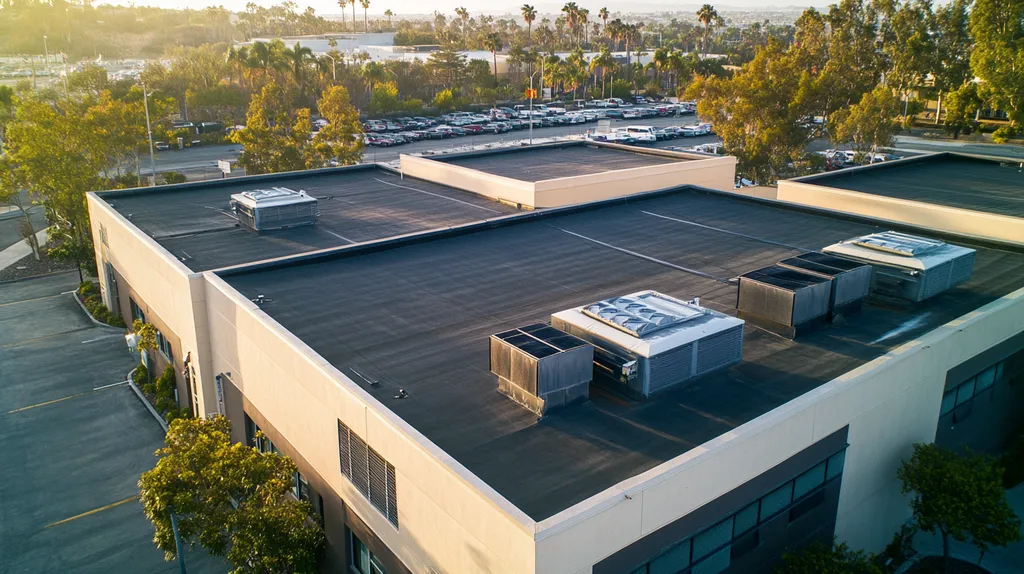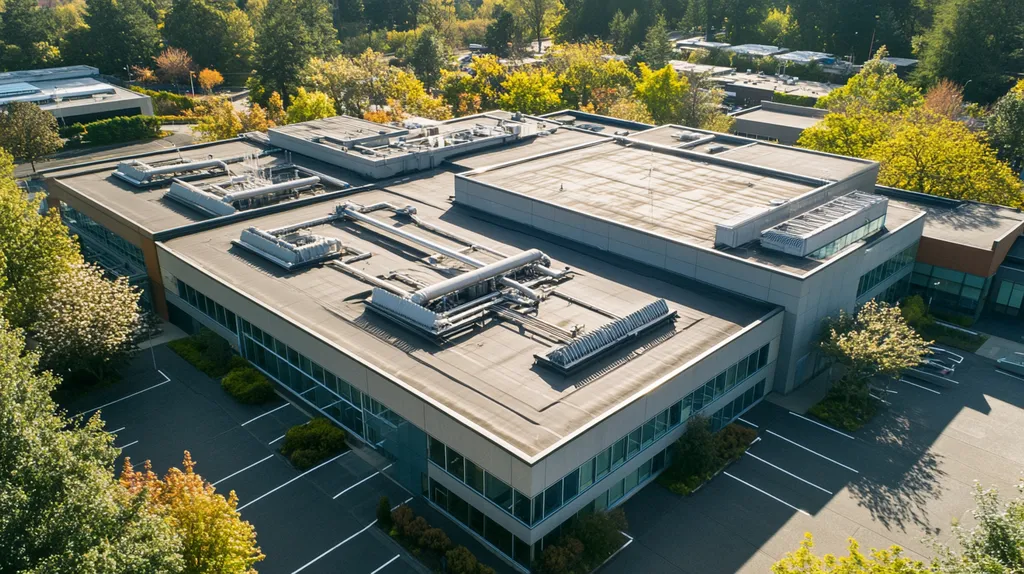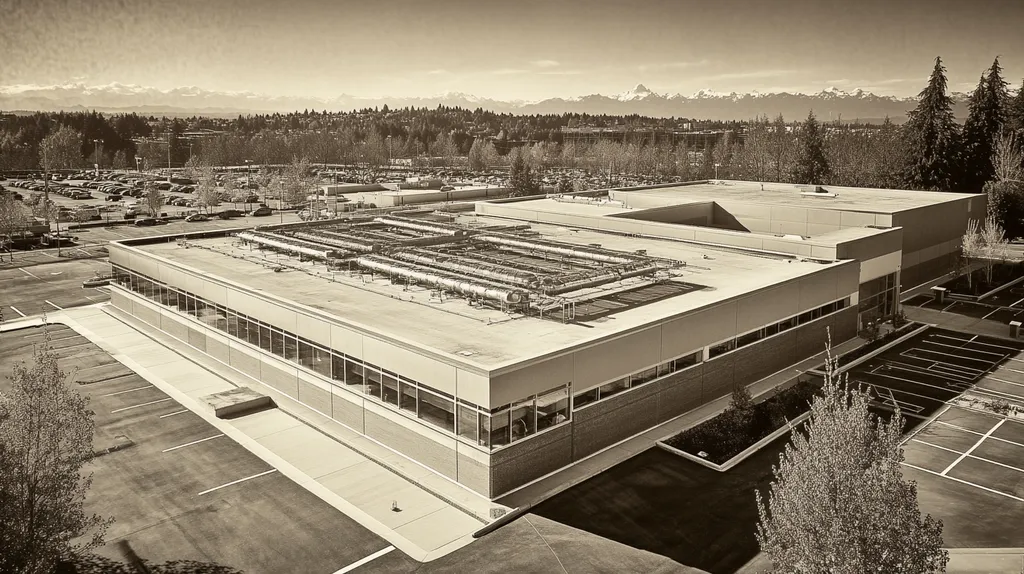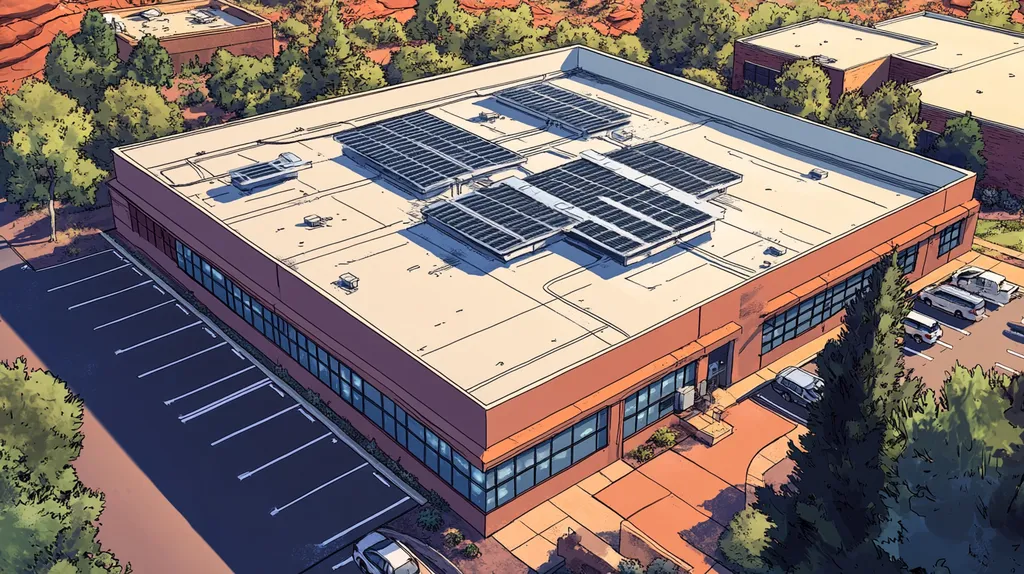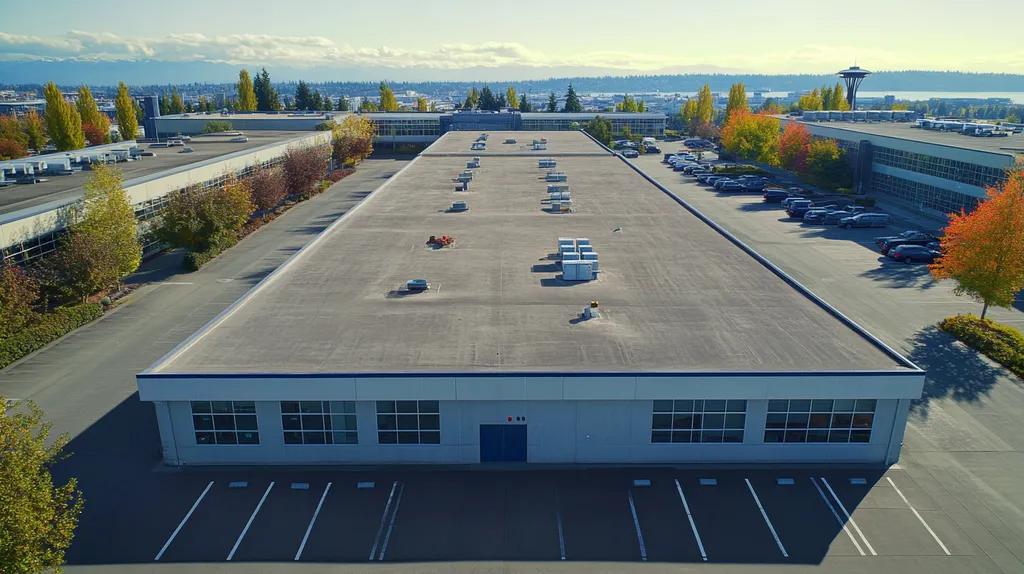In the high-stakes world of commercial roofing, hazardous materials pose an invisible threat that costs the industry over $2 billion annually in health-related expenses and regulatory fines.
From decades-old asbestos lurking in roof membranes to silica dust released during repairs, these hidden dangers create a minefield of potential disasters for facility managers.
By debunking common myths and establishing evidence-based protocols, property owners can protect both their workforce and their bottom line while navigating the complex landscape of hazardous materials management.
SECTION 1: COMMON MISCONCEPTIONS
Facility managers often navigate a minefield of misconceptions that can result in serious health risks and legal challenges. Shockingly, studies reveal that nearly 30% of commercial roofs built before 1980 may harbor asbestos—an invisible threat that, if ignored, can lead to substantial fines, project disruptions, and dire health outcomes for employees. Clearing up these myths about hazardous materials is essential for making informed and responsible roofing decisions.
Ignoring Asbestos in Older Buildings
Asbestos should be at the forefront of concerns for any facility manager dealing with older buildings. Far too often, the health risks associated with asbestos fibers are underestimated. Disturbing these fibers during roofing renovations can trigger serious respiratory diseases like mesothelioma. This often happens when inspectors miss or misjudge the presence of asbestos.
Many facility managers mistakenly believe that if asbestos isn’t in plain sight, it’s not a problem. This assumption is misleading and dangerous. Asbestos can lurk in insulation, roofing materials, and even beneath well-worn floors. To ensure safety, establishing an asbestos risk assessment should be standard protocol for any building constructed before the 1980s.
Following local regulations surrounding asbestos is absolutely essential. Non-compliance can lead to severe fines or abruptly halted projects. Even worse, mishandling asbestos can expose workers to health risks, potentially resulting in lawsuits against facility management.
By actively managing asbestos risks, facility managers not only protect their employees but also their organization’s financial health. Investing in thorough assessments and remediation strategies can significantly minimize long-term liabilities while fostering a safer working environment.
Misunderstanding Silica Hazards
Facility managers often overlook the grave hazards posed by silica dust, which can emerge during roofing work with concrete or masonry. Silica exposure is linked to critical health issues, including silicosis and lung cancer. It’s important to recognize that simple ventilation or dust control measures may not suffice in preventing exposure.
Some property owners erroneously assume that using personal protective equipment (PPE) alone is enough to shield workers. This can lead to a false sense of security. Relying exclusively on PPE, without implementing robust engineering controls, creates dangerously unsafe working conditions. Effective training and comprehensive workplace policies are necessary to tackle the risks associated with silica exposure.
Moreover, OSHA has stringent regulations regarding silica exposure. Ignoring these rules can have severe ramifications for businesses, including hefty fines and soaring insurance premiums. Hence, being well-informed about proper handling protocols is essential to shield facilities from potential financial impacts.
Recognizing and addressing silica hazards is crucial for ensuring a safe working environment and safeguarding employee health. Facility managers should prioritize continuous education and periodic assessments of silica risks within roofing operations to maintain compliance and ensure safety.
Overlooking Lead Paint Risks
Lead paint is often a silent threat in older buildings, especially harmful to vulnerable populations like children. Any facility manager working on roofs or structures built before 1978 must account for the possible presence of lead-based paints. Neglecting this risk could lead to contamination during renovation activities.
There’s a widespread misconception that lead paint only poses a threat during demolition phases. In reality, any disturbance—whether from sanding, scraping, or natural wear—can release harmful lead particles. Lacking lead-safe practices can result in dangerous exposure for workers and the surrounding communities.
Neglecting proper lead paint management can also result in serious legal implications. Facility managers who are found in violation of lead regulations may incur substantial penalties. More critically, they risk the health of their workforce and the nearby population.
To mitigate these risks, proactive evaluation and testing for lead paint should be integrated into project planning for older facilities. Ensuring that effective safety measures are in place not only protects workers but also defends against potential legal and financial penalties.
SECTION 2: PRACTICAL IMPLICATIONS
When it comes to handling hazardous materials during roofing operations, the stakes are high. Each year, OSHA estimates that over 400,000 workers encounter these dangerous substances across various industries, including roofing. Ignoring the implications of this exposure can lead to serious health issues, skyrocketing insurance costs, and even legal troubles for facility managers. This makes understanding the practical implications of hazardous materials handling vital for effective risk management in the roofing sector.
Health Risks for Roofing Personnel
Roofing professionals frequently come into contact with hazardous materials like asbestos, lead, and volatile organic compounds (VOCs). Prolonged exposure to these harmful substances can result in severe health problems, including respiratory issues, skin disorders, and even cancer. Risks increase significantly during demolition or repair tasks, where older roofing materials may conceal hidden toxins.
The dangers aren’t just physical. Working in hazardous environments can create significant psychological stress. Employees may experience anxiety regarding their health and safety, which can depress morale and productivity. Companies that overlook these health risks might find themselves not only battling health crises but also facing reduced employee engagement and higher turnover.
Providing essential training and protective equipment is crucial in managing these risks. By ensuring that employees have what they need to stay safe, companies can create a work environment that minimizes injuries and keeps absenteeism in check.
Ultimately, proactively addressing health risks related to hazardous materials is essential for both workforce protection and operational effectiveness.
Compliance with OSHA Regulations
OSHA has established stringent guidelines concerning the handling of hazardous materials, requiring businesses to implement safety measures that protect employees. Ignoring these regulations can lead to substantial fines and costly legal battles that threaten a company’s viability.
For example, maintaining Material Safety Data Sheets (MSDS) for all hazardous substances at the site is mandatory. Failing to keep these up-to-date not only breaches OSHA guidelines but also jeopardizes workers’ safety by leaving them unaware of potential risks. Regular training sessions are essential for keeping roofing crews informed about compliance standards.
Being compliant with OSHA regulations isn’t just about avoiding penalties; it also enhances a company’s reputation. With clients more focused on safety and environmental responsibility, demonstrating compliance can strengthen business relationships and open doors to new contract opportunities.
Moreover, fostering a strong culture of safety through compliance leads to greater employee satisfaction and retention in the long run.
Impact on Roofing Operations
The manner in which hazardous materials are handled significantly impacts overall roofing operations. Insufficient safety measures can cause project delays, cancellations, and inflated operational costs. An incident related to hazardous materials can bring progress to a grinding halt while extensive cleanup and remediation take place.
Additionally, failing to properly manage hazardous materials can severely damage a business’s reputation. Negative public perception not only deters potential clients but also diminishes profitability.
Conversely, investing in effective hazardous materials handling can streamline operations. Companies prioritizing safety are less likely to experience interruptions, allowing them to stick to project timelines and budgets. This commitment can lead to long-term savings and a more robust position in the market.
In summary, the implications of hazardous materials handling reach far beyond immediate health concerns; they impact safety policies, operational efficiency, and overall company reputation.
SECTION 3: COST OF MISINFORMATION
The stakes are incredibly high when handling hazardous materials on roofs. In 2020 alone, companies faced over $200 million in fines due to non-compliance with safety regulations. Misinformation can lead to costly decisions that not only impact the bottom line but also put worker safety and company reputation at serious risk. Facility managers must grasp the financial, health, and reputational repercussions that can arise from ignoring accurate information about hazardous materials.
Financial Penalties for Non-Compliance
Ignoring guidelines for hazardous material management can incur severe financial penalties. Government agencies strictly enforce regulations, imposing fines that can skyrocket into the millions for non-compliance. For example, a roofing contractor that sidesteps safety protocols may receive citations, stalling their projects and resulting in substantial revenue losses.
Additionally, non-compliance can expose companies to lawsuits. If employees develop health issues due to exposure, organizations could be liable for medical expenses and lost wages. When legal fees and reputational damage come into play, the financial burden only escalates.
However, proper training and accurate information about hazardous materials can help avoid these hefty fines. By investing in compliance, facility managers can save money while safeguarding their company’s financial future.
In many instances, the initial cost of compliance training is minimal compared to the potential losses from fines and litigation. Accurate information isn’t just a legal requirement; it’s a smart investment.
Long-Term Health Costs for Workers
Misinformation regarding hazardous materials can have serious health implications for workers. Exposure to toxic substances like asbestos or lead paint can lead to chronic health conditions, including respiratory diseases and cancers. These health risks often result in years of suffering and hefty healthcare expenses.
Companies that neglect safety training may also face rising insurance premiums over time. If occupational diseases develop, workers’ compensation claims will surge, eventually impacting the organization’s bottom line.
Moreover, the long-term absence of affected workers can disrupt operations. A shortage of personnel can result in project delays, harming both productivity and profitability.
Investing in proper hazardous materials handling is crucial for protecting workers and freeing businesses from undue long-term costs. It’s an investment in human capital that pays significant dividends in the end.
Damage to Company Reputation
In today’s competitive market, a company’s reputation is priceless. Misinformation about hazardous materials can spark public relations disasters. If it comes to light that a company mishandled hazardous substances, the fallout can be swift and severe.
Negative publicity from such incidents can deter potential clients and push existing ones to reconsider their partnerships. Facility managers must recognize that maintaining a strong reputation can outweigh any short-term financial gain from cutting corners.
Furthermore, stakeholders often conduct due diligence before forging partnerships. Companies with a track record of compliance failures or safety issues may struggle to form beneficial relationships, severely limiting their growth potential.
Ultimately, consistent and transparent handling of hazardous materials not only enhances worker safety but also fortifies a company’s brand integrity. In a connected world, a solid reputation can take years to build but only moments to tarnish.
SECTION 4: REALITY CHECK
When it comes to hazardous materials on roofs, the stakes couldn’t be higher for facility managers and property owners. Ignoring the potential dangers can lead to severe health issues and staggering legal liabilities. Understanding the real hazards, the critical importance of proper documentation, and effective removal protocols is essential to protect both people and investments. This section tackles common misconceptions while shining a light on pivotal elements of hazardous materials management.
Actual Hazards of Roofing Materials
The risks tied to commonly used roofing materials are often underestimated by facility managers. For instance, solvents and adhesives—ubiquitous in roofing projects—can trigger respiratory issues and skin irritations when improperly handled. Furthermore, older roofs may harbor hazardous substances like lead or asbestos, which can pose significant health threats if disturbed.
Another crucial area to be aware of is the hazardous waste generated during roof replacements. Materials such as modified bitumen and fiberglass can release harmful fibers if mishandled, underscoring the need for stringent safety protocols during installation or replacement.
Failing to acknowledge these hazards can have far-reaching implications, extending beyond just worker health. Regulatory fines and remediation costs can climb quickly if hazardous materials are not managed properly, making it imperative for property owners to prioritize safety in their handling practices.
Education about these hidden dangers is the first step toward ensuring a safer work environment. Ongoing training equips facility managers with the knowledge they need to navigate risks and implement best practices effectively.
Importance of Safety Data Sheets (SDS)
Safety Data Sheets (SDS) are critical yet often overlooked resources for facility managers. These documents detail the hazards, handling requirements, and emergency procedures for each roofing material used. Regular access to and review of SDS not only fosters a culture of safety but also empowers staff to work more confidently.
Understanding the contents of SDS can significantly minimize risks. For example, being aware of the appropriate personal protective equipment (PPE) required for specific materials can prevent injuries on site. This proactive approach safeguards both employees and the property itself.
Moreover, maintaining a well-organized system for SDS helps ensure compliance with local regulations. Not having current SDS on hand can lead to penalties during inspections and audits, which can be both costly and disruptive.
It’s crucial for facility managers to schedule regular reviews of SDS for all roofing materials. These check-ups not only bolster safety but also reinforce accountability among team members.
Asbestos Removal Protocols
Asbestos continues to be a significant concern within the roofing industry due to its hazardous properties. If asbestos is present in a roof, following strict removal protocols is essential to guarantee safety during the tear-off process. Many misconceptions surrounding DIY asbestos removal can lead to dangerous and often life-threatening consequences.
Facility managers should only hire licensed professionals who are trained to follow Environmental Protection Agency (EPA) guidelines for asbestos removal. This includes establishing controlled work areas and using specialized equipment designed to prevent airborne exposure.
Effective communication is also vital during the removal process. It’s important to inform all stakeholders, including employees and building occupants, about potential risks and the safety protocols implemented. Such transparency not only fosters trust but also contributes to a safe working environment.
Regular training on handling asbestos and staying aware of legal implications can greatly enhance employee safety. By understanding the health effects and compliance requirements, facility managers can diligently adhere to established protocols, ensuring the safety of everyone involved.
SECTION 5: EVIDENCE-BASED ALTERNATIVES
Managing hazardous materials on rooftops is not just about compliance; it’s about protecting lives and livelihoods. With thousands of injuries reported each year due to improper handling of these materials, facility managers must be proactive in implementing effective safety strategies. Fortunately, evidence-based alternatives can significantly reduce risks and ensure adherence to industry regulations. This section explores the vital roles of Personal Protective Equipment (PPE), targeted training programs, and clear labeling practices in fostering a safer roofing environment.
Proper Use of Personal Protective Equipment (PPE)
Utilizing the right PPE is crucial in reducing exposure to hazardous materials. Facility managers should establish clear protocols detailing the necessary equipment for specific jobs. For instance, when handling substances like asbestos or roofing tar, respiratory masks, gloves, and protective eyewear are indispensable.
Designated areas demanding PPE must be clearly marked, with signage that reminds workers to gear up. Regular audits can help ensure adherence to these safety measures and identify shortages in equipment. Providing comfortable and well-fitted PPE encourages higher compliance rates among workers.
Investing in high-quality, industry-specific PPE is essential. Facilities using inadequate or substandard gear risk exposing employees to dangerous conditions, leading to potential lawsuits. A robust PPE strategy signals a company’s commitment to employee safety and regulatory compliance.
Annual reviews of PPE practices should be standard to incorporate advancements in technology and materials. Adapting to new hazardous conditions in the roofing industry helps ensure that employees are equipped with the most effective protection available.
Training Programs for Hazardous Materials
Robust training programs are integral for safely managing hazardous materials. Facilities must provide comprehensive education on identifying, handling, and disposing of hazardous substances to ensure all staff are aware of potential risks and safety measures.
Regular training sessions and refresher courses keep these critical safety protocols at the forefront. Organizations with structured training initiatives typically experience lower incident rates than those neglecting employee education. Emphasizing hands-on experience reinforces essential concepts effectively.
Including emergency response in training can empower workers to act swiftly during incidents. Simulated scenarios of hazardous material exposure prepare staff for real-life situations, cultivating a safety-first culture that mitigates repercussions.
Documenting training is essential not only for compliance but for fostering continuous improvement. Clear records allow facilities to assess training effectiveness and implement necessary adjustments based on feedback and regulatory changes.
Labeling and Signage for Hazardous Areas
Effective labeling and signage in hazardous areas are non-negotiable for ensuring safety. Signs should convey easy-to-understand instructions and warnings, helping workers recognize potential risks while adhering to safety measures. Color coding can enhance visibility and comprehension significantly.
Facilities must position signage strategically at entry points and throughout work areas. Properly designed labels identifying hazardous materials, specifying PPE requirements, and listing emergency contacts can prove lifesaving in roofing environments.
Regular assessments of signage effectiveness are necessary to maintain clarity and relevance. Outdated or damaged signs must be replaced immediately to avoid confusion. Engaging workers in discussions about signage can lead to improvements that reflect their practical insights.
Moreover, embracing digital signage technology offers dynamic solutions for providing real-time updates on hazardous material risks. Investing in innovative signage methods demonstrates a facility’s commitment to optimal safety standards while remaining responsive to evolving industry needs.
SECTION 6: TEST AND VERIFY
When it comes to commercial roofing, the stakes surrounding hazardous materials are incredibly high. A staggering 80% of chronic illnesses are related to indoor air quality, much of which is linked to the improper handling of roofing materials. Regular testing and thorough audits are essential not just for employee safety, but also for averting potential legal woes. By committing to proactive measures, facilities can maintain a safe environment and mitigate substantial liabilities.
Conducting Regular Safety Audits
Regular safety audits are vital for uncovering hazardous materials lurking atop roofs. Facilities should establish a consistent audit schedule to actively seek out harmful substances, such as asbestos and lead, especially prevalent in older roofing systems.
These audits must be performed by trained professionals who are well-versed in local regulations and aware of the nuances associated with various roofing materials. Overlooking these assessments can result in severe repercussions like hefty fines and damage to a company’s reputation.
Thorough documentation of each audit is crucial. Reports should outline findings, recommend actions, and establish timelines for necessary remediation. This not only aligns with safety regulations but also cultivates a proactive safety culture within the organization.
Moreover, regular audits can reveal underlying issues that, if ignored, could escalate into structural damage or expensive repairs. Investing in preventive maintenance through safety audits enhances the lifespan and integrity of roofing systems.
Testing for Hazardous Substances
Routine testing is indispensable for managing hazardous substances on roofs efficiently. Property managers should collaborate with certified laboratories to analyze samples suspected of containing hazardous materials. This includes heavy metals, volatile organic compounds (VOCs), and other contaminants, which can seep into the workplace environment.
Timely testing empowers facilities to make informed decisions regarding repairs or replacements. For example, discovering asbestos would necessitate strict remediation protocols to protect workers during roofing activities.
Implementing standard operating procedures for testing can streamline operations, clearly defining who conducts the tests and how results are communicated. Additionally, leveraging advanced detection technologies can enhance accuracy while potentially reducing labor costs.
Staying current with testing not only supports compliance with OSHA and EPA regulations but also protects the health of everyone in the building. Awareness of hazardous substances enables targeted actions that effectively lower health risks.
Documenting Compliance and Procedures
Maintaining meticulous records of compliance and safety procedures is essential for mitigating the risks associated with hazardous materials. Facilities should create a centralized documentation system to track all safety audits, tests, and remediation efforts.
This record-keeping serves multiple functions: it chronicles compliance efforts, assists in training new staff, and safeguards the organization against inspections or legal claims. Without thorough documentation, facilities run the risk of greater legal exposure and increased scrutiny from regulatory bodies.
Regularly reviewing documentation helps pinpoint gaps and ensures that procedures remain up-to-date. Effectively communicating these protocols to all stakeholders, including management and contractors, enhances accountability across the board.
In summary, a robust documentation system not only strengthens safety practices but also boosts operational efficiency. It illustrates a facility’s commitment to safety and environmental stewardship, traits that are increasingly valued in today’s business landscape.
The Bottom Line
With hazardous materials causing over $2 billion in annual health-related costs to the roofing industry, facility managers can no longer afford to ignore these invisible threats.
From properly identifying asbestos in aging structures to implementing rigorous safety protocols, the path forward requires a dramatic shift in how the industry approaches hazardous materials management.
Success hinges on three critical factors: comprehensive training programs, regular testing and documentation, and unwavering commitment to safety compliance.
By debunking dangerous myths and embracing evidence-based solutions, facility managers can protect their workforce while avoiding the crippling financial penalties and reputational damage that come from mishandling these materials.
The choice is clear: adapt to modern safety standards or risk becoming another cautionary tale in an industry where mistakes can prove fatal.
FREQUENTLY ASKED QUESTIONS
Q. What misconceptions exist about commercial roofs and asbestos?
A. Many facility managers mistakenly believe asbestos isn’t a problem if it isn’t visible. However, asbestos can be present in various roofing materials and insulation, posing severe health risks if disturbed during renovation. Performing a thorough asbestos risk assessment is essential for ensuring safety.
Q. How do hazardous materials affect operations on an industrial roof?
A. Hazardous materials can halt roofing operations due to health concerns, leading to project delays and increased costs. For instance, exposure to silica dust without proper management can result in serious health issues, causing work stoppages while safety protocols are implemented.
Q. What are the financial risks of not managing hazardous materials on roofs?
A. Failing to comply with hazardous materials regulations can lead to hefty fines and potential litigation, which may financially cripple a business. It’s essential to invest in compliance and staff training to avoid these severe financial consequences.
Q. Why is understanding Safety Data Sheets vital for commercial roofing?
A. Safety Data Sheets (SDS) provide crucial information regarding hazards and safety measures for materials used in roofing. Regular access to SDS helps ensure workers understand the risks and proper handling techniques, promoting a safer work environment.
Q. What role do audits play in hazardous materials management for roofs?
A. Routine safety audits help identify hazardous materials on roofs and ensure compliance with local regulations. These assessments can prevent dangerous situations by uncovering potential risks before they become significant liabilities for your facility.
Q. How can labeling improve safety on industrial roofs?
A. Effective labeling on industrial roofs alerts workers to hazardous materials and required protective equipment. Clear signage enhances visibility and understanding of risks, significantly improving workplace safety and compliance with regulations.
Q. What should facility managers know about testing for hazardous materials?
A. Regular testing is crucial for identifying hazardous materials like heavy metals or VOCs. Collaborating with certified labs ensures that samples from roofs are accurately analyzed, enabling informed decision-making regarding necessary safety protocols and remediation strategies.
Q. What proactive measures can ensure safety when handling hazardous materials?
A. Implementing robust training programs, supplying appropriate PPE, and conducting regular safety audits are vital. These proactive approaches significantly reduce exposure risks, fostering a safer environment for facility managers and their teams.

